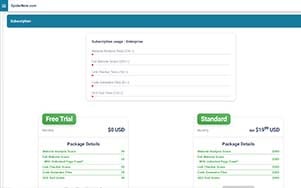Why clear website navigation is crucial
Clear website navigation is crucial for several reasons:
- It improves user experience: When users can easily navigate through your website, they are more likely to stay longer and explore more pages. This improves their overall experience and increases the chances of conversions or desired actions.
- It boosts SEO rankings: Search engines like Google consider user experience as an important factor when determining search rankings. Websites with clear navigation are more likely to rank higher in search results, leading to increased organic traffic.
- It reduces bounce rate: If users struggle to find what they are looking for or get confused by complicated navigation, they are more likely to leave your website. Clear navigation helps reduce bounce rate and keeps users engaged.
- It enhances accessibility: Clear navigation makes your website more accessible to users with disabilities or impairments. Properly labeled links and intuitive navigation help these users navigate through your website effortlessly.
In summary, clear website navigation is crucial for improving user experience, boosting SEO rankings, reducing bounce rate, and enhancing accessibility.
How does intuitive website navigation impact website analytics?
Intuitive website navigation can impact website analytics in several ways:
1. Lower Bounce Rates: Intuitive navigation reduces bounce rates as users are more likely to stay on the website and explore multiple pages.
2. Longer Session Durations: Clear navigation encourages users to spend more time on the website, leading to longer session durations and increased engagement metrics.
3. Higher Conversion Rates: Intuitive navigation guides users through the conversion funnel more effectively, resulting in higher conversion rates and improved performance metrics.
How does intuitive website navigation impact search engine rankings?
Intuitive website navigation can impact search engine rankings in several ways:
1. Crawlability: Clear and logical navigation structures make it easier for search engine crawlers to discover and index all pages of the website, improving overall crawlability and ensuring that content is properly indexed.
2. User Experience Signals: Search engines prioritize websites that provide a positive user experience, including easy navigation and clear information architecture. Intuitive navigation can lead to lower bounce rates, longer session durations, and higher engagement metrics, which are positive signals for search engine rankings.
3. Accessibility: Intuitive navigation benefits users with disabilities by making it easier to navigate the website using assistive technologies. Search engines may reward websites that prioritize accessibility with higher rankings.
Understanding the importance of breadcrumb navigation
Breadcrumb navigation is a secondary navigation system that displays the user's current location within the website's hierarchy. It typically appears horizontally at the top of the page, showing the path the user has taken to arrive at the current page. For example, a breadcrumb trail for a product page might look like Home > Category > Subcategory > Product.
Breadcrumb navigation is important for several reasons:
- It provides context: Breadcrumbs help users understand their current location within the website and how it relates to other pages. This can be especially useful for websites with complex structures or deep hierarchies.
- It improves navigation: Breadcrumbs allow users to quickly navigate back to higher-level pages without having to rely solely on the main menu or back button. This saves time and enhances the overall user experience.
- It enhances SEO: Breadcrumb navigation can improve the internal linking structure of your website, which is beneficial for SEO. Search engines can easily crawl and understand the relationships between pages, resulting in improved search rankings.
By implementing breadcrumb navigation on your website, you can provide users with a clear understanding of their location and improve the overall navigation experience.
Implementing intuitive main menu navigation
The main menu navigation is often the primary method for users to explore different sections or pages of a website. Implementing intuitive main menu navigation is crucial for ensuring a seamless user experience. Here are some tips to consider:
- Keep the main menu visible and easily accessible on all pages of your website. Users should be able to find it without any effort.
- Use clear and concise labels for each menu item. Avoid using jargon or overly technical terms that may confuse users.
- Consider using drop-down menus or submenus for organizing subpages or subsections. However, ensure that the menus are easy to navigate and do not overwhelm users with too many options.
By implementing intuitive main menu navigation, you can provide users with a clear and organized way to navigate through your website.
Utilizing footer navigation effectively
The footer of a website often contains additional navigation links that are useful for users. Utilizing footer navigation effectively can enhance the overall user experience. Consider the following tips:
- Include important links in the footer, such as contact information, privacy policy, terms of service, and sitemap.
- Group related links together to make it easier for users to find the information they need.
By utilizing footer navigation effectively, you can provide users with additional navigation options and enhance their overall experience on your website.
Optimizing navigation for mobile devices
With the increasing use of mobile devices, it is crucial to optimize website navigation for smaller screens. Here are some tips to ensure mobile-friendly navigation:
- Use a responsive design that adjusts the navigation layout based on the screen size. This ensures that the navigation remains accessible and user-friendly on mobile devices.
- Simplify the navigation menu for mobile devices. Consider using a hamburger menu icon that expands to reveal the menu options when tapped.
- Prioritize the most important pages or sections in the mobile navigation menu. Avoid overwhelming users with too many options.
- Ensure that the navigation elements are large enough and easy to tap with a finger. This improves usability on touchscreens.
- Test the mobile navigation on different devices and screen sizes to ensure it provides a seamless experience for mobile users.
By optimizing navigation for mobile devices, you can cater to the growing number of mobile users and provide them with a user-friendly experience on your website.










